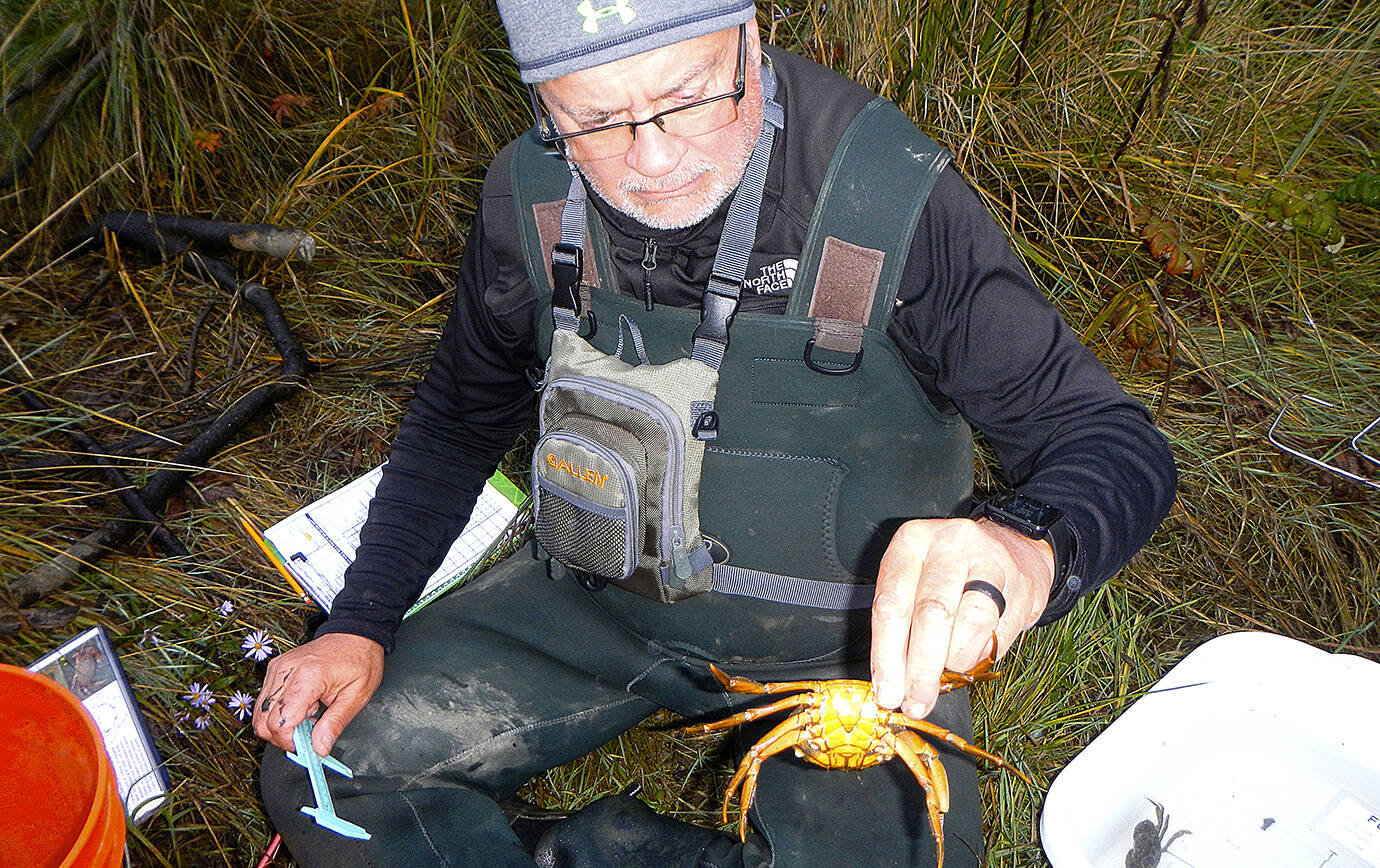In the spring, the Washington Sea Grant volunteer Crab Team began monitoring Grays Harbor and Willapa Bay for invasive European green crab, which are growing in numbers and can wreak havoc on native species.
New coastal monitoring sites, termed “sentinel sites,” were established in locations that were monitored monthly between April and September with the purpose of tracking green crab and native crab populations.
“When we found out that almost all of the five new sentinel sites were located in Willapa Bay — three sites in Willapa Bay, one in Grays Harbor and one in Makah Bay — we reached out to Washington Sea Grant’s Crab Team,” said Twin Harbors Waterkeeper Lee First. “They didn’t waste any time and quickly determined that South Aberdeen met the conditions for a good sentinel trapping site.”
The Daily World reported on the early goings back in May, describing the threat posed by the diminutive invaders.
“It is a highly invasive species known for destroying habitats and out-competing or consuming native species in the areas they invade,” said First. “Highly effective predators, they are adept at opening bivalve shells, and they’ve been blamed for harming the soft shell clam industry on the U.S. East Coast.”
European green crab eat almost anything, including eelgrass, considered an ecological “foundation species” because so many other species rely on it.
“Destroying eelgrass meadows is especially concerning because this important plant provides habitat for salmonids, crab, herring, shellfish, shrimp, and waterfowl,” said First.
“Eelgrass meadows, salt marshes, coastal wetlands, and other shallow tidal habitats are especially efficient in removing carbon dioxide from the air and surrounding waters. This carbon dioxide that coastal wetland ecosystems absorb from the atmosphere is known as ‘blue carbon.’ (The crab’s) appetite for blue carbon eelgrass is yet another cause for concern.”
They also compete for the same food sources of native fish, shellfish and bird species.
European green crab were first seen in San Francisco Bay in 1989. They moved north and were sighted in Willapa Bay and Grays Harbor in 1998 and 1999. At first their population was closely monitored, and they appeared to decline. But in the last few years, their populations in Southwest Washington’s estuaries have dramatically increased, said First.
First and other local volunteers set out to do their part in monitoring local European green crab populations.
“In order to start our sentinel site trapping, we took several hours of intensive training online, and a week later, Alex Stote, Coastal Green Crab Specialist from the Washington Sea Grant, met us on site,” she said.
“She brought a whole kit of stuff: two kinds of traps, bait, data sheets, measuring calipers, identification guides, cool stickers, and more. In no time, she made us feel like experts. We set the traps on an incoming tide, and the next morning, she showed up bright and early to help us identify and document our catch.”
Sentinel trapping is used to help map the distribution of where the crab are found. More intensive efforts are assessments and/or removal trapping — these focus on determining green crab hot spots and removing the most crabs as possible.
“Removal trapping is being done in both Grays Harbor and Willapa Bay by Pacific County, as well as the Makah Tribe, and the Shoalwater Bay Indian Tribe,” said First. “The Lummi Nation in the Salish Sea is operating a robust removal trapping program. In 2021, over 2,500 were caught and removed in Willapa Bay, and over 2,800 have been removed from Grays Harbor via removal trapping.”
Sentinel trapping data is still being reviewed by Sea Grant’s Crab Team staff. Every single site in Grays Harbor and Willapa Bay found green crab.
Sentinel site trapping results for September 2021 include five at South Aberdeen, five at Bay Center, five at Brady’s, two at Grays Harbor Refuge, 25 at Nahcotta, eight at Ocean Shores, and 19 in Tokeland.
”Now that all the data has been submitted, Crab Team staff will work on compiling an end-of-season report, which will include site totals and averages, and where possible, comparisons to what we saw in 2020,” said First.
First said those who depend on the Southwest Washington estuaries for fish, crab and oysters are “very worried. The potential impacts to eelgrass are especially worrisome. For these reasons, we hope additional efforts are employed very soon.”
First will keep doing her part, along with other local volunteers like Craig Zora.
“In the Twin Harbors Waterkeeper site operated in South Aberdeen, we caught an average of 5-10 European green crab almost every time we set the traps,” said First.
“We may have been covered with mud, drenched by rain and pinched by crabs, but we learned the names of a bunch of native crabs, shrimp, fish and eels, and in the end we felt like we accomplished something.”


